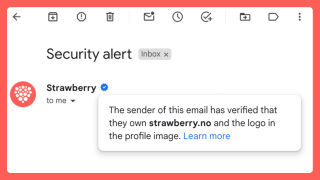Have you noticed anything different about the emails you have received from us recently? Our emails have undergone a minor, yet ever-so-crucial technical update! From now on, the emails you receive from us will feature a blue verification mark and our logo. Moreover, our website now has an even more secure login process.
Phishing, spoofing, emails scams and online crimes are becoming increasingly common. For those of us wanting to offer our customers a flexible and secure online experience, we are of course doing everything we can to stay at the forefront of the latest developments to keep you and your information safe. Adding a verification mark, our logo and a two-step verification process are key steps along the way to achieving this.
“The hotel industry is facing an increase in tempting scam emails and phishing attacks, whereby fraudsters try to lure guests into sharing sensitive information. With VMC and BIMI, we are able to improve security through clear brand verification, allowing recipients to easily identify emails from us. Such security efforts are just as important as ensuring the wellbeing of our guests.”
Martin Belak, Director of Digital Development
What difference does a verification mark make?
The blue mark means that you can trust that the email from Strawberry was actually sent by us and that it isn’t a scam email. Perhaps you recognise the verification mark from company and celebrity accounts on Instagram and Facebook? The corresponding function for email is called Verified Mark Certificate (VMC), and this blue mark is a security badge that guarantees the authenticity of the sender. It is used by email service providers such as Google, Yahoo, Fastmail and Apple (for iCloud accounts).
The logo also means that it is easier for you to recognise emails from us, regardless of whether we’re sending you a booking confirmation or a newsletter. The technology used to add a logo to emails is called BIMI.
For those interested in the technicalities, let’s just say that the process of adding a logo and verification mark to emails is pretty complicated. Your company must have been active for a number of years, you need to trademark your logo, you will have to verify that you own your domain name(s) by allowing the certificate issuer to check your company details with the domain registry, and more. That’s probably the reason why you see so few company logos in your inbox – only 0.5% of all Nordic companies currently offer this level of security. It is a highly effective way to protect recipients from scam emails – criminals would simply not manage to go through all these security steps.

This is what the logo and the blue tick look like in Google's email service.
Security improvements for strawberry.se
We are also offering improved security for all members who log in to our website using two-step verification. This requires an extra security step (in addition to the password) to log in, and it is an effective way to ensure that only you have access to your account, your data and your bonus points.
Cyber Security Glossary
Verification mark: Called different things by different actors but the appearance is the same across most platforms. A little blue tick guarantees that an account belongs to the person or the company it says it does. The process of getting a verified account varies, but generally has high credibility on the major platforms like Instagram and Facebook.
Phishing: Involves emails being sent with the purpose of tricking the recipient into sharing personal information, often by clicking on a link in the email. These emails have become increasingly sophisticated over time and often appear to come from well-known companies, e.g. Netflix, banks or delivery notices for parcels.
Two-step verification: Using two steps to log in – a password plus one additional step. The second step requires a unique one-time code that is active for a limited time. The process can also be called two-factor authentication or 2FA.

